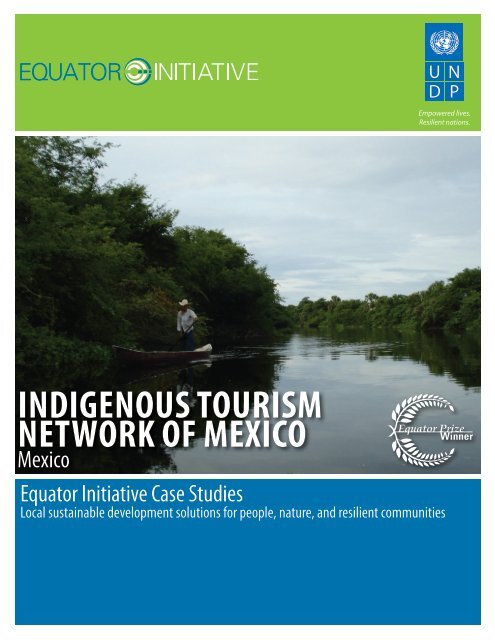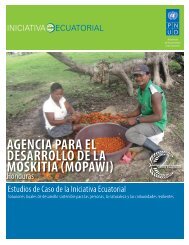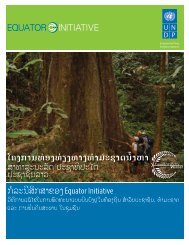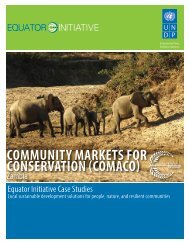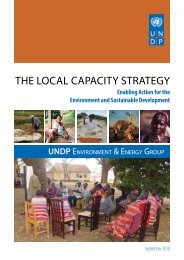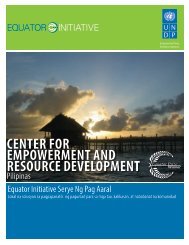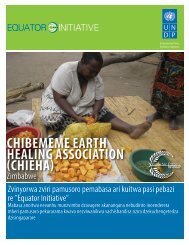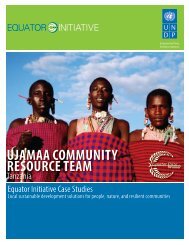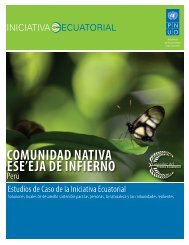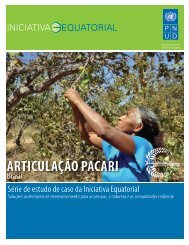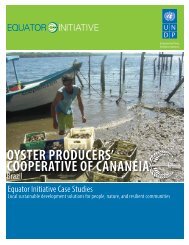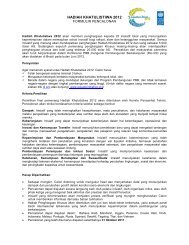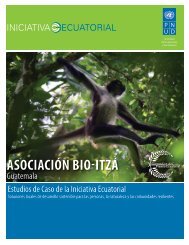INDIGENOUS TOURISM NETWORK OF MEXICO - Equator Initiative
INDIGENOUS TOURISM NETWORK OF MEXICO - Equator Initiative
INDIGENOUS TOURISM NETWORK OF MEXICO - Equator Initiative
Create successful ePaper yourself
Turn your PDF publications into a flip-book with our unique Google optimized e-Paper software.
Empowered lives.<br />
Resilient nations.<br />
<strong>INDIGENOUS</strong> <strong>TOURISM</strong><br />
<strong>NETWORK</strong> <strong>OF</strong> <strong>MEXICO</strong><br />
Mexico<br />
<strong>Equator</strong> <strong>Initiative</strong> Case Studies<br />
Local sustainable development solutions for people, nature, and resilient communities
UNDP EQUATOR INITIATIVE CASE STUDY SERIES<br />
Local and indigenous communities across the world are advancing innovative sustainable development solutions that work<br />
for people and for nature. Few publications or case studies tell the full story of how such initiatives evolve, the breadth of<br />
their impacts, or how they change over time. Fewer still have undertaken to tell these stories with community practitioners<br />
themselves guiding the narrative.<br />
To mark its 10-year anniversary, the <strong>Equator</strong> <strong>Initiative</strong> aims to fill this gap. The following case study is one in a growing series<br />
that details the work of <strong>Equator</strong> Prize winners – vetted and peer-reviewed best practices in community-based environmental<br />
conservation and sustainable livelihoods. These cases are intended to inspire the policy dialogue needed to take local success<br />
to scale, to improve the global knowledge base on local environment and development solutions, and to serve as models for<br />
replication. Case studies are best viewed and understood with reference to ‘The Power of Local Action: Lessons from 10 Years of<br />
the <strong>Equator</strong> Prize’, a compendium of lessons learned and policy guidance that draws from the case material.<br />
Click on the map to visit the <strong>Equator</strong> <strong>Initiative</strong>’s searchable case study database.<br />
Editors<br />
Editor-in-Chief:<br />
Managing Editor:<br />
Contributing Editors:<br />
Joseph Corcoran<br />
Oliver Hughes<br />
Dearbhla Keegan, Matthew Konsa, Erin Lewis, Whitney Wilding<br />
Contributing Writers<br />
Edayatu Abieodun Lamptey, Erin Atwell, Toni Blackman, Jonathan Clay, Joseph Corcoran, Larissa Currado, Sarah Gordon, Oliver Hughes,<br />
Wen-Juan Jiang, Sonal Kanabar, Dearbhla Keegan, Matthew Konsa, Rachael Lader, Patrick Lee, Erin Lewis, Jona Liebl, Mengning Ma,<br />
Mary McGraw, Gabriele Orlandi, Juliana Quaresma, Peter Schecter, Martin Sommerschuh, Whitney Wilding, Luna Wu<br />
Design<br />
Oliver Hughes, Dearbhla Keegan, Matthew Konsa, Kimberly Koserowski, Erin Lewis<br />
Acknowledgements<br />
The <strong>Equator</strong> <strong>Initiative</strong> acknowledges with gratitude the Indigenous Tourism Network (RITA) of Mexico, and in particular the guidance and<br />
inputs of Cecilio Solís. All photo credits courtesy of RITA. Maps courtesy of CIA World Factbook and Wikipedia.<br />
Suggested Citation<br />
United Nations Development Programme. 2012. Indegenous Tourism Network of Mexico, Mexico. <strong>Equator</strong> <strong>Initiative</strong> Case Study Series. New<br />
York, NY.
<strong>INDIGENOUS</strong> <strong>TOURISM</strong><br />
<strong>NETWORK</strong> <strong>OF</strong> <strong>MEXICO</strong><br />
Mexico<br />
PROJECT SUMMARY<br />
The Indigenous Tourism Network of Mexico promotes a selfreliance<br />
approach to indigenous community development,<br />
emphasising sustainable livelihoods in communities working<br />
for the conservation and sustainable use of biodiversity.<br />
The organization, primarily focused on ecotourism and<br />
microenterprises, mobilises indigenous communities<br />
through a collaborative and participatory network with the<br />
aim of overcoming economic marginalization.<br />
The Network includes 17 groups in 15 states, and over<br />
5,000 members. It is leveraged to attract investment, offer<br />
training, find markets for local products, and advocate for<br />
indigenous rights. Training services focus on improving<br />
the operational, administrative, and financial capacity of<br />
indigenous microenterprise. Artisans are trained to use local<br />
materials and to cultivate herbal and medicinal plants, and<br />
‘tourism circuits’ have been established to direct income<br />
generating opportunities to the Network’s members.<br />
KEY FACTS<br />
EQUATOR PRIZE WINNER: 2010<br />
FOUNDED: 2002<br />
LOCATION: 15 of 31 Mexican states<br />
BENEFICIARIES: 17 indigenous Mexican groups<br />
BIODIVERSITY: Wildlife Management Conversation Units<br />
TABLE <strong>OF</strong> CONTENTS<br />
Background and Context 4<br />
Key Activities and Innovations 7<br />
Biodiversity Impacts 8<br />
Socioeconomic Impacts 9<br />
Policy Impacts 10<br />
Sustainability 11<br />
Replication 11<br />
Partners 12<br />
3
Background and Context<br />
As its name implies, the Indigenous Tourism Network of Mexico<br />
(Red Indígena de Turismo de México A.C. - RITA) is a network of tourism<br />
companies and microenterprises that are run by 17 indigenous<br />
Mexican groups - the Purepecha, Nahua, Popoluca, Chinanteco,<br />
Amuzgo, Mazahua, Tlahuicas, Hñañhus, Zapotec, Mazatec, Totonac,<br />
Mam, Chol, Tzotzil, Tzeltal, Maya Masehual and Maya Peninsular<br />
groups. These indigenous groups are spread throughout 15 Mexican<br />
states. RITA was created in October 2002 when representatives of 32<br />
indigenous tourism companies met in Trinidad Tlaxcala and decided<br />
that the creation of a network of indigenous tourism groups, led<br />
and managed by indigenous people, was both possible and desirable.<br />
In the decade since RITA’s establishment, the number of groups<br />
involved has grown steadily and regional sub-networks have also<br />
formed within the larger RITA network. Today, RITA is comprised of<br />
160 microenterprises, many of which are also involved in one of its<br />
13 regional sub-networks.<br />
These companies offer a wide variety of services, each based on its<br />
own experiences, interests and circumstances. However, all of the<br />
companies engage in projects that focus on conversation and the<br />
sustainable use of nature, while also training members in indigenous<br />
rights, cultural revaluation and indigenous identity. RITA’s presence<br />
in 15 of the country’s thirty-one states and federal district means<br />
that the organization works in a variety of landscapes including<br />
forest, jungle, swamp, wetland and desert ecosystems. While each<br />
company works autonomously, best practices are shared within the<br />
network to strengthen and enrich the work of RITA companies. Table<br />
1 lists the companies and regional networks active in each of the 15<br />
states where RITA operates.<br />
Capitalizing on natural wealth<br />
A central motivation for the creation of RITA was to address the<br />
marginalization of indigenous people, who traditionally attain the<br />
lowest levels of well-being according to Mexican statistics (e.g. low<br />
educational attainment, poor employment opportunities and low<br />
income), despite being located in territories with abundant biodiversity<br />
compared to the rest of the nation. According to Mexico’s 2005<br />
population and housing census (the latest available at the time of<br />
writing), approximately 9 million indigenous people, constituting 14<br />
per cent of the total national population, live in approximately 5,700<br />
rural communities in central and southern Mexico in extreme poverty.<br />
Simultaneously, Mexico is among the most biodiverse country<br />
in world, with the majority of its most biodiverse areas located in<br />
indigenous territories. Furthermore, water that is captured in these<br />
areas services not only these ecosystems, but the larger population<br />
of the country.<br />
4
Table 1: RITA companies and sub-networks by state<br />
State Companies (not part of a regional sub-network) Regional Networks<br />
Campeche<br />
Chiapas<br />
Distrito Federal<br />
Guererro<br />
Ecotourism Cabanas of U Beel Maya<br />
The Root of the Future<br />
New Alliance Ecotourism Center<br />
Chol Xumulhá<br />
Mayan Women of Jovel<br />
Umbral Axochiatl<br />
Yoloxmichin<br />
Flowers of the Amuzga Land<br />
Sirenito Macho<br />
Union of the Landholders of the Caves of Cacahuamilpa<br />
Tzeltal Tzotzil Circuit<br />
Lumal Maya<br />
Xochipa Network<br />
Guerrero Indigenous Tourism Network<br />
Hidalgo Hña Hñu Network Hñahñu Indigenous Network of Alternative Tourism<br />
Mexico<br />
Michoacán<br />
Morelos<br />
Oaxaca<br />
Puebla<br />
Quintana Roo<br />
Tabasco<br />
Tlaxcala<br />
Veracruz<br />
Yucatan<br />
Source: RITA (2010)<br />
Tecehliqui S.C.<br />
Valley of the Nuns<br />
La Tzararacua Ecotourism Center<br />
Pantzingo Ecotourism Center<br />
Atekokolli Traditional Medicine Center<br />
Quetzálcoatl Ecotourism Community<br />
Temachtiani<br />
Tlayecanqueh<br />
Capulalpam Magic Ecotourism Community<br />
Nijme<br />
Hotel Taselotzin<br />
Teht-Tlan Community Tourism<br />
Xkit Turismo de Aventura<br />
Cave of the Hanging Serpents<br />
U Belilek Kaxtik Kuxtal<br />
The Black Chon<br />
Oto’t Isla Santa Anita<br />
Integrated Rural Development Project of Vicente Guerrero<br />
Cascadas Encantadas Ecotourism Center<br />
Red Mangrove Ecotourism Center<br />
Tortoiseshell Ecotourism Center<br />
U Najil Ek Balám<br />
Indigenous Network of the State of Mexico<br />
Ecomich<br />
Nahua Morelense Community<br />
RETA Totaltipak<br />
Umeya Maya Oob<br />
Tabasco Network<br />
South Veracruz Network<br />
Alternative Indigenous Tourism Network of the<br />
Yucatan Maya<br />
RITA was born out of the idea that the lives of indigenous communities<br />
could be improved by taking advantage of the paradoxical situation<br />
whereby the most impoverished groups were sitting on the<br />
country’s greatest concentration of natural riches. By developing a<br />
network of indigenous tourism companies, indigenous communities<br />
could capitalize on the rich natural resources in their communities<br />
to generate income. In this way, RITA seeks to promote ‘indigenous<br />
tourism’ as a source of substantial economic development in<br />
indigenous regions. It also seeks to utilize the existing knowledge<br />
and interest of indigenous communities in the realization of conservation<br />
projects and the development of alternative uses of the biological<br />
and cultural diversity of their territories.<br />
A further driver of the initiative’s creation was the desires to take<br />
ownership of the right to development that indigenous peoples<br />
have, a right recognized at both the national and international levels,<br />
and to reflect the natural and cultural wealth of indigenous territories,<br />
which should primarily serve to further the development and<br />
food security of their inhabitants. The initiative was also an attempt<br />
to challenge outsiders’ perspectives of indigenous peoples through<br />
cultural revaluation, and additionally to change indigenous people’s<br />
perspectives of themselves, to strengthen their identity as agents of<br />
their own development.<br />
Goals and governance principles<br />
RITA works with its member companies to overcome poverty in the<br />
indigenous communities involved in the initiative. The goal is not<br />
5
only to attain a higher income, but to provide means for families<br />
and communities to improve their social and economic situations<br />
through a sustainable process of development. At the same time,<br />
efforts are made to ensure the continuity of cultural and environmental<br />
values. In carrying out its work, RITA adheres to the principles<br />
of fraternity; respect of differences; honesty; gender equity; cultural<br />
revaluation and sustainable use of environmental resources; development<br />
while maintaining identity; cooperation and mutual support<br />
among members of the network and other governmental and<br />
non-governmental authorities; tolerance between different groups<br />
within society; recognition the efforts made by members, fraternal<br />
groups, and others actors; and social inclusion, respect, and full<br />
rights of indigenous peoples.<br />
RITA’s governance structure consists of a General Assembly and a<br />
Board of Directors. The General Assembly reviews and assesses the<br />
actions taken during the previous fiscal year and recommends further<br />
actions for implementation in the next period. The Board of Directors,<br />
comprised of a president, secretary and treasurer, manages<br />
RITA’s resources and directs its activities in order to implement the<br />
recommendations and tasks as set out by the General Assembly. The<br />
Board also implements actions for the cultivation of new institutional<br />
relationships.<br />
The General Assembly and Board of Directors are supported by several<br />
coordinating units. A Training Coordinator designs methods and<br />
materials for use in workshops, courses and seminars for members. A<br />
Multidisciplinary Management Team executes actions mandated by<br />
the General Assembly and Board of Directors in the field and office.<br />
A Community Outreach Monitoring Committee ensures marketing<br />
goals have been satisfied and monitors performance. A Project Coordinator<br />
implements and develops projects in the field and in the<br />
office to synthesize and display projects. A Coordinator on Climate<br />
Change represents RITA in forums regarding indigenous working<br />
methods, forms of ancestral conservation, and the positioning of indigenous<br />
peoples. An Area Outreach Promotion and Marketing Coordinator<br />
performs all of RITA’s marketing and promotion operations<br />
and makes necessary contacts for distribution and sales of services.<br />
The governance structure also includes three external relations<br />
groups. An Institutional Relations group follows and maintains RI-<br />
TA’s relationships with government agencies, NGOs, organizations,<br />
businesses, and schools. A Latin American Relations group monitors<br />
relations with tourism microenterprises in the wider Latin America<br />
region in order to develop knowledge exchange and build institutional<br />
capacity. An External Advisory Council advises the Board of<br />
Directors regarding future actions. Finally, the Legal and Accounting<br />
group provides legal and accountancy advice to RITA and its members.<br />
RITA’s business model involves the creation of three-year strategic<br />
work plans that are reviewed and revised each year and are subject<br />
to consensus and consideration by its members. RITA adheres to<br />
two main principles in conducting all of its activities. First of all, that<br />
projects are initiated only with the approval of community members,<br />
since they are aware of the special circumstances of their own<br />
communities, and second, that women are encouraged to join the<br />
initiatives and hold equal authority and responsibilities. RITA also<br />
promotes responsible and equitable commercialization of biological<br />
and cultural diversity for these tourist companies.<br />
6
Key Activities and Innovations<br />
RITA’s network of 160 indigenous tourism microenterprises together<br />
employs approximately 5,000 people throughout 15 Mexican states.<br />
The network is leveraged to attract investment, offer training opportunities,<br />
find markets for local products, coordinate with national<br />
and international forums, and advocate for indigenous rights. To attract<br />
investment and promote the tourism services of its members,<br />
RITA has established an annual National Tourism Fair. Activities at the<br />
fair fairs include expositions and sales of tourism services; sales of<br />
indigenous art and cuisine; displays of indigenous music and dance;<br />
and panels on indigenous tourism and sources of financing for tourism<br />
companies. The first festival was held in 2009 in Mexico City, the<br />
second in 2010 in the city of Puebla, and future fairs are planned, to<br />
be held each year, moving between the states where RITA member<br />
companies are active.<br />
While other ecotourism networks exist in the global south, RITA is innovative<br />
in that it goes beyond focusing on conservation to include<br />
the advancement of indigenous communities - namely, enhancing<br />
the economic stability of its indigenous members, with a focus on<br />
maintaining their cultural heritage. To this end, the initiative has<br />
provided training to indigenous members in order to enhance their<br />
skills and teach them techniques to manage, operate and market<br />
their own products and services.<br />
To strengthen its network, RITA provides training services to its member<br />
microenterprises, focusing on improving their operational, administrative<br />
and financial capacity. Since its inception, RITA has held<br />
over 30 such workshops, on topics ranging from biodiversity as an<br />
alternative for development of indigenous villages, to management<br />
of computer equipment and internet services. Other workshops topics<br />
have included management of ecotourism in protected areas, hygiene<br />
in services, and analysis of legal figures. These workshops are<br />
frequently held in several states to facilitate greater attendance. To<br />
offer further support to its members, RITA conducts diagnostic censuses<br />
of their activities and services in order to determine and share<br />
best practices, thus allowing members to learn from each other’s<br />
successes and challenges.<br />
In addition to providing members with training opportunities, RITA<br />
supports them by providing equipment and other assistance. Between<br />
2005 and 2008, RITA provided computers to 34 microenterprises,<br />
created promotional videos for 16, designed and printed brochures<br />
for the promotion of 32, and designed and hosted websites<br />
for 16. RITA also created and later evaluated 32 tourist projects for its<br />
member companies.<br />
7
Impacts<br />
BIODIVERSITY IMPACTS<br />
RITA has taken part in Mexico’s Wildlife Management Conversation<br />
Unit program (Unidad de Manejo Ambiental - UMA), a successful strategy<br />
that grants communities control of the use of their local natural<br />
resources. The UMA system is a legal tool used by the Ministry of<br />
Environment and Natural Resources of Mexico to encourage the use<br />
and conservation of biodiversity by indigenous and local communities<br />
in national territories. Landowners may apply for UMA status,<br />
which requires that the land or other resource be used in a manner<br />
that conserves existing natural resources, directly or indirectly,<br />
under a plan for sustainable management. In turn, the landowners<br />
retain the economic benefits derived from the resources. Several of<br />
RITA’s territories have been granted UMA status. For example, two<br />
units were designated in relation to the Tzararacua Waterfall in Michoacan,<br />
one for the white-tailed deer and the other for the iguana;<br />
in Xochimilco, one unit was obtained for a biological station dedicated<br />
to the conservation of the axolotl (an endangered endemic<br />
species). In Puebla Xluluc, one unit was obtained for the protection<br />
of the iguana.<br />
In the state of Tlaxcala, communities regenerated an eroded and<br />
barren area of land, converting it to productive land through the use<br />
of traditional, organic techniques, conserving native corn while protecting<br />
soil and forest. In Tuxtlas Veracruz, in Cacahuamilpa, an observatory<br />
has been established for the measurement and protection<br />
of the common swift populations living in caves there. In Guerrero<br />
Marquelia, efforts to conserve Olive Ridley, Leatherback, Green, and<br />
Hawksbill Turtles have resulted in the release of about 30,000 hatchling<br />
turtles each year.<br />
Through the work of its member companies, RITA has made several<br />
major achievements in protecting habitats. For example, in Guerrero,<br />
the community is responsible for managing the famous Cacahuamilpa<br />
grottos, one of the largest cave systems in the world. In Nuevo<br />
San Juan Parangaricutiro in Michoacán, the community operates a<br />
forest reserve of over 11,000 hectares of the area surrounding the<br />
Paricutín volcano and the Tancítaro mountain range. In Kantemó in<br />
Quintana Roo, the community maintains a reserve of deciduous forest,<br />
and bats, snakes, and other aquatic species living in the Cave of<br />
the Hanging Snakes have been protected. In the Juarez Mountains<br />
of Oaxaca, communities manage several thousand hectares of forest,<br />
conserving a very important portion of the Papaloapan River<br />
watershed.<br />
8
Through workshops, RITA emphasizes the importance of the measurement<br />
and monitoring aspects of its work, which involve systematizing<br />
and preparing relevant reports to present to the Council<br />
level of companies or communities in order to take any necessary<br />
actions. Each tourism microenterprise formulates its own monitoring<br />
and measurement system in accordance with the surrounding<br />
environment, using traditional indigenous methods to measure the<br />
biodiversity impacts of their work.<br />
Some RITA microenterprises have also partnered with the Mexican<br />
government in the conservation of biodiversity. An example is<br />
the co-administration of the caves of Cacahuamilpa. The government,<br />
represented by the National Commission of Protected Areas<br />
(CONANP), joined together with people from surrounding communities<br />
and succeeded in generating the income necessary to improve<br />
the quality of life in the region and improve the care of the local environment,<br />
including these caves. Another example is Xochimilco<br />
Biological Station which deals with the conservation of the axolotl,<br />
a species endemic to the channels of the lake region of Mexico City.<br />
SOCIOECONOMIC IMPACTS<br />
RITA aims to improve the lot of indigenous communities by generating<br />
permanent employment for indigenous people. When RITA<br />
was established in 2002, the 32 microenterprises that comprised the<br />
network had poor infrastructure and were not operating to their fullest<br />
potential. With RITA’s assistance, they have been able to develop<br />
projects that provide a range of integrated services such as cabanas,<br />
restaurants, trails and saunas, resulting in increased income to members<br />
companies.<br />
The development of tourism initiatives reduced communities’ dependence<br />
on agricultural uses of the land, which traditionally provide<br />
unsteady incomes, with little or no income in the off-season.<br />
RITA’s assistance in creating and developing projects within these<br />
communities has provided a steady source of income beyond the<br />
minimum wages in respective regions.<br />
RITA’s 160 member microenterprises currently employ approximately<br />
5,000 people. Assuming four members per family, this employment<br />
supports approximately 20,000 people. In this way, the indigenous<br />
communities associated with RITA have benefitted greatly<br />
from their involvement in the network.<br />
RITA’s level of inclusion is to be commended, and ensures that the<br />
benefits of its projects are shared as widely as possible in the communities<br />
it works with. Overall, approximately 1,500 women are<br />
beneficiaries of the initiative. Some companies are fully comprised<br />
of women, such as la Masehual Siuame de Puebla, Flowers of the<br />
Amuzga Land of Xochistlahuaca in Guerrero, and the Mayan Women<br />
of Jovel of San Cristóbal. RITA’s three-year work plans are approved<br />
by members, and regular meetings with the various indigenous<br />
groups are held to share experiences and work methods, ensuring<br />
that all members’ voices are heard.<br />
Secondary benefits<br />
In addition to improving the economic welfare of its members and<br />
their wider, RITA’s work has also resulted in secondary benefits. Development<br />
can be seen in personal projects aimed at identifying<br />
leadership capacity in the region. For example, youth are already<br />
playing a part in the conservation movement.<br />
Further secondary benefits of RITA’s work can be seen in the work<br />
of several specific microenterprises. For example, in Guerrero, programs<br />
have been established that allow for some of the revenue<br />
from the Cacahuamilpa grottos project to be directed towards improvements<br />
in the infrastructure of the four neighboring communities.<br />
These funds have been used to provide support to schools,<br />
improve medical services, and pay for paving and sewage systems.<br />
Similarly, in Nuevo San Juan Parangaricutiro in Michoacan, there has<br />
also been investment of income to community services in the municipality.<br />
In Capulálpam de Mendez in Oaxaca, the management of<br />
the community’s resources resulted in its acceptance into the Federal<br />
Tourism Ministry’s ‘Magical Towns’ program, a program created<br />
to preserve and promote the culture, ecology and history of towns<br />
9
throughout Mexico. As part of this program, communities receive<br />
funding from the national government to develop concepts and services<br />
in order to attract visitors and improve local infrastructure.<br />
Despite such examples of progress, indigenous communities are<br />
still in Mexico’s lower economic strata. This motivates RITA’s members,<br />
through their regional leadership, to increase involvement and<br />
membership in the initiative, in order to integrate the regional networks<br />
and further communities’ opportunities for advancement.<br />
POLICY IMPACTS<br />
The right of indigenous communities to make autonomous decisions<br />
regarding the management of their territories underlies all of<br />
RITA’s work. In this respect, RITA represents its indigenous members<br />
at national and international forums. In 2009, RITA representatives<br />
attended the 15th Conference of the Parties to the United Nations<br />
Framework Convention on Climate Change (COP 15) in Copenhagen<br />
to take part in the preparation of the indigenous manifesto on global<br />
biodiversity conservation, as well as attended various national and<br />
international forums on environmental issues and climate change.<br />
Similarly, RITA secured a seat at the COP16, in Cancun, Mexico in<br />
2010. RITA was the host organization of the indigenous delegates<br />
represented at COP16, and with its Latin American counterparts,<br />
worked to defend the rights of indigenous peoples regarding the<br />
environment and their right to make decisions pertaining to their<br />
territories. In addition, as part of Latin American representation of<br />
indigenous peoples, the presentation of RITA’s Coordinator on Climate<br />
Change had influence in international forums, including the<br />
2010 Mérida Declaration of the Third Mesoamerican Congress of<br />
Protected Areas.<br />
Furthermore, RITA’s members often participate as speakers at various<br />
forums and workshops on environmental issues and indigenous<br />
rights. In addition to involving members in these issues, these workshops<br />
and forums have also presented a platform for RITA to advocate<br />
for policy change regarding the attitudes towards indigenous<br />
peoples. RITA has advocated that indigenous peoples must be considered<br />
an entity capable of representing their portion of the national<br />
population. Additionally, several RITA members serve on Advisory<br />
Councils, legal bodies created by the Mexican state.<br />
RITA has achieved some success in pursuing its goals in the judicial<br />
realm. In the Tlahuica region of Mexico, agricultural judicial authorities<br />
gave a favorable verdict to RITA communities that resulted in<br />
the local indigenous community being granted control over almost<br />
24,000 hectares in the area of the Zempoala lagoons. This decision,<br />
after half a century of litigation, was achieved after RITA had contact<br />
with and contributed to the empowerment of community leaders<br />
from the town of San Juan Atzingo.<br />
RITA has also made preparations to form an Indigenous Business<br />
Chamber of Mexico, a proactive plan to integrate other sectors or<br />
branches into the organization and bring together people in similar<br />
fields, or industrial or services activities, to share best practices.<br />
This idea has been welcomed by the International Labour Organization,<br />
the National Autonomous University of Mexico and the Spanish<br />
Agency of International Cooperation and Development.<br />
In terms of influencing policy, RITA cites corruption, and government<br />
and legal initiatives that are unfavorable towards indigenous<br />
people as the greatest barriers to its success. RITA’s proposals have<br />
also frequently been rejected as being traditional and anachronistic,<br />
and their efforts have often been ignored due to a lack of formal results<br />
and organization. However, through capacity building, RITA has<br />
become more prepared and its members have begun to overcome<br />
these barriers. Now, government projects and programs are beginning<br />
to take into account the needs and practices of indigenous<br />
communities, which has resulted in a greater number of invitations<br />
to participate in policymaking.<br />
“RITA would provide three pieces of advice to other communities who wish to create<br />
an effective and sustainable project on biodiversity conservation. First, prioritize your<br />
achievements and traditional knowledge, and align local concerns with development plans<br />
that are measurable in the short and medium term. Second, you must ensure that the input of<br />
advisers and consultants is appropriate for local conditions, that interventions are focused<br />
on providing permanent employment, and not only temporary, and that regarding natural<br />
resources, you have real plans for preservation, not exploitation. Third, you must gain a clear<br />
understanding of all required administrative, legal and marketing tools, so that they do not<br />
inadvertently undermine progress. Information technology is an area of work that assists, it is<br />
not an end; it is only a means to organize and to define appropriate control in the daily work of<br />
the company.”<br />
Cecilio Solís, RITA<br />
10
Sustainability and Replication<br />
SUSTAINABILITY<br />
Since its establishment, RITA has sustained its growth on a<br />
foundation of credibility and service to its members. The key element<br />
contributing to the sustainability of the initiative is its people.<br />
Traditional indigenous livelihoods have always been sustainable<br />
and their enhanced capacity to deal with administrative, legal and<br />
commercial challenges has given them the ability to adapt to change<br />
and overcome competition successfully. RITA’s next step is to focus<br />
on strengthening the protection of the environment. Currently,<br />
there is a shift towards environmental education in the work of RITA’s<br />
member microenterprises. Indigenous people, with their wealth of<br />
local knowledge, are the best providors of this training.<br />
One of RITA’s weaknesses in maintaining sustainability pertains<br />
to the establishment of marketing systems in order to provide<br />
a continuous flow of visitors. While RITA has begun to take action<br />
to market their members’ tourism services through brochures and<br />
websites, more work in this area is needed. Financial stability is also<br />
an issue, as RITA now acts as a socially-based network, rather than a<br />
consultant as it did formerly. Consequently, RITA must find resources<br />
to operate and strengthen the network’s infrastructure and capacity.<br />
Some of RITA’s financial issues were alleviated in 2009, when RITA<br />
applied for financing from the Inter-American Development Bank<br />
for a project entitled ‘Consolidation of a Network of Indigenous<br />
Microenterprises through the Enhancement of Regional Tourism’.<br />
The project was approved for an amount of USD 149,662, with an<br />
additional USD 91,208 coming from national co-financing, achieving<br />
total project funding of USD 240,870. The purpose of this project is<br />
for RITA’s member companies to develop a uniform system of tourism<br />
services and promotion of their attractions, while maintaining the<br />
regional identity of each microenterprise.<br />
REPLICATION<br />
As mentioned previously, while the RITA network began with 32<br />
member companies in 2002, the number has since grown to 160,<br />
with 13 regional sub-networks now in operation. RITA has also<br />
shared its experiences with various groups at both the national and<br />
continental levels in order to facilitate the development of similar<br />
initiatives in other regions and countries.<br />
RITA has provided the basis for the creation of the Indigenous Tourism<br />
Network of the Americas, a network sponsored by the University<br />
“Indigenous communities’ way of life and work offer an alternative way of living to the<br />
demands of modern economies, characterized by a common cause and coexistence with their<br />
peers and their natural environment. This is a proven path, and has brought indigenous people<br />
centuries of peace and satisfaction; politicians should consider this, to promote harmonious<br />
relations between different groups in society.”<br />
Cecilio Solís, RITA<br />
11
of Stanford, and Redturs, a Latin American community tourism<br />
network co-sponsored by the International Labor Organization. RITA<br />
is a founding partner in both networks.<br />
In addition, RITA has shared its model through a large number of<br />
workshops with various governmental and non-governmental<br />
agencies, and has given talks and seminars at national universities<br />
as well as abroad. In sharing knowledge, RITA stresses the following<br />
points: how to strengthen community-based tourism networks with<br />
infrastructure; negotiating power with the authorities; models of<br />
financial sustainability; capacity for self-management of projects;<br />
and mainly, environmental and cultural issues specific to indigenous<br />
peoples.<br />
RITA’s work has also been replicated through its events, in form if not<br />
always in concept or idea. Two examples are The National Indigenous<br />
Tourism Fair called ‘Indigenous Heart of America’. In addition to<br />
Mexican indigenous groups, this fair also considers the villages of<br />
South America, and has sent invitations to African villages. This will<br />
enhance the impact and presence achieved by RITA, as well as the<br />
interaction between the indigenous groups in different parts of the<br />
world.<br />
PARTNERS<br />
Among the most notable agencies that support the project are the<br />
Spanish Agency of International Cooperation and Development, the<br />
National Autonomous University of Mexico, the National Commission<br />
for the Development of Indigenous Peoples, the Multilateral Investment<br />
Fund (IDB-MIF), The Association of Development Financing<br />
Institutions (La Asociación de Instituciones Financieras de Desarrollo<br />
- FINRURAL), the Ministry of Social Development, and the National<br />
Institute for Social Development, among others. Their contributions<br />
have been monetary, providing financing for RITA’s three-year business<br />
plans or have consisted of contributions to specific projects.<br />
RITA appreciates that these partners have or pushed for thematic or<br />
visionary adjustments in the projects.<br />
12
FURTHER REFERENCE<br />
• Indigenous Tourism Network of Mexico website http://www.rita.com.mx/<br />
• Indigenous Tourism Network of Mexico Photo Story (Vimeo) http://vimeo.com/15964775<br />
Click the thumbnails below to read more case studies like this:<br />
<strong>Equator</strong> <strong>Initiative</strong><br />
Environment and Energy Group<br />
United Nations Development Programme (UNDP)<br />
304 East 45th Street, 6th Floor<br />
New York, NY 10017<br />
Tel: +1 212 906-6691<br />
Fax: +1 212 906-6642<br />
www.equatorinitiative.org<br />
The United Nations Development Programme (UNDP) is the UN’s global development network, advocating for change and connecting<br />
countries to knowledge, experience and resources to help people build a better life.<br />
The <strong>Equator</strong> <strong>Initiative</strong> brings together the United Nations, governments, civil society, businesses and grassroots organizations<br />
to recognize and advance local sustainable development solutions for people, nature and resilient communities.<br />
©2012 by <strong>Equator</strong> <strong>Initiative</strong><br />
All rights reserved


